中国饮食文化中英文解读
- 格式:pdf
- 大小:1.68 MB
- 文档页数:8
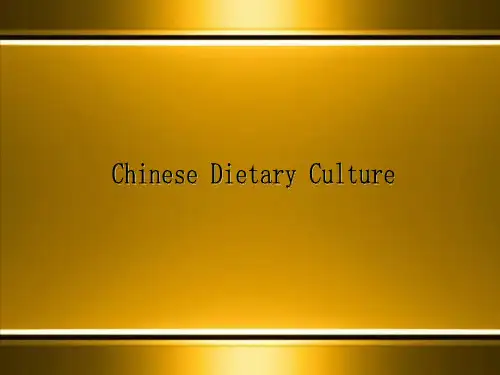
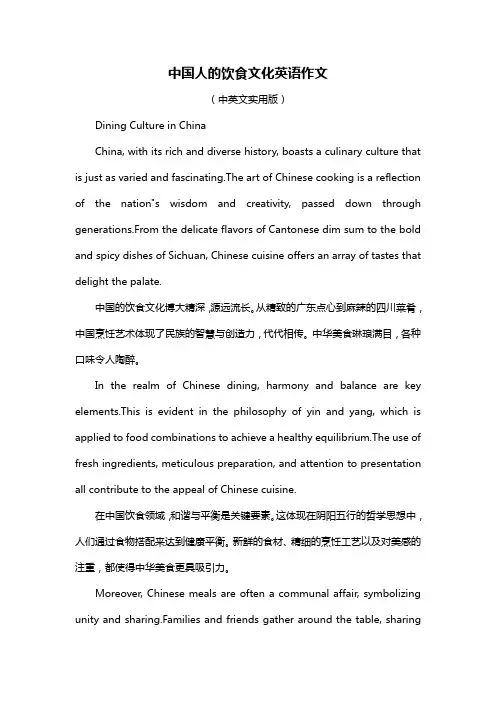
中国人的饮食文化英语作文(中英文实用版)Dining Culture in ChinaChina, with its rich and diverse history, boasts a culinary culture that is just as varied and fascinating.The art of Chinese cooking is a reflection of the nation"s wisdom and creativity, passed down through generations.From the delicate flavors of Cantonese dim sum to the bold and spicy dishes of Sichuan, Chinese cuisine offers an array of tastes that delight the palate.中国的饮食文化博大精深,源远流长。
从精致的广东点心到麻辣的四川菜肴,中国烹饪艺术体现了民族的智慧与创造力,代代相传。
中华美食琳琅满目,各种口味令人陶醉。
In the realm of Chinese dining, harmony and balance are key elements.This is evident in the philosophy of yin and yang, which is applied to food combinations to achieve a healthy equilibrium.The use of fresh ingredients, meticulous preparation, and attention to presentation all contribute to the appeal of Chinese cuisine.在中国饮食领域,和谐与平衡是关键要素。
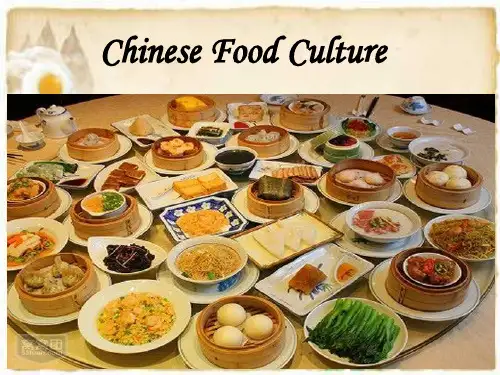
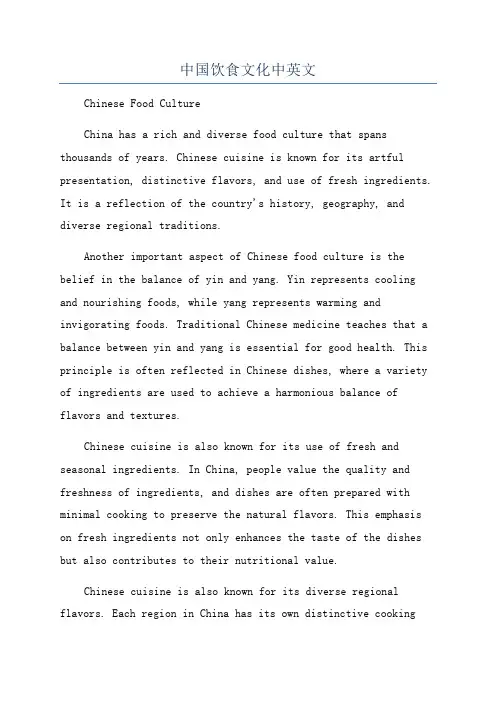
中国饮食文化中英文Chinese Food CultureChina has a rich and diverse food culture that spans thousands of years. Chinese cuisine is known for its artful presentation, distinctive flavors, and use of fresh ingredients. It is a reflection of the country's history, geography, and diverse regional traditions.Another important aspect of Chinese food culture is the belief in the balance of yin and yang. Yin represents cooling and nourishing foods, while yang represents warming and invigorating foods. Traditional Chinese medicine teaches that a balance between yin and yang is essential for good health. This principle is often reflected in Chinese dishes, where a variety of ingredients are used to achieve a harmonious balance of flavors and textures.Chinese cuisine is also known for its use of fresh and seasonal ingredients. In China, people value the quality and freshness of ingredients, and dishes are often prepared with minimal cooking to preserve the natural flavors. This emphasis on fresh ingredients not only enhances the taste of the dishes but also contributes to their nutritional value.Chinese cuisine is also known for its diverse regional flavors. Each region in China has its own distinctive cookingstyles and specialty dishes. For example, Sichuan cuisine is known for its bold and spicy flavors, while Cantonese cuisine focuses on freshness and subtle flavors. These regional differences result in a rich and varied culinary tradition that is unique to China.In addition to the variety of flavors, Chinese cuisine also places a strong emphasis on the visual presentation of dishes. Chinese chefs take great care in arranging the ingredients and creating visually appealing dishes that are not only pleasing to the taste buds but also to the eyes. This attention to detail makes Chinese cuisine a true form of culinary art.Furthermore, Chinese food culture is deeply rooted in symbolism and tradition. Certain foods and dishes are associated with special occasions and festivals. For example, dumplings are traditionally eaten during the Chinese New Year as they symbolize wealth and good fortune. Similarly, fish is often served during festive occasions as it represents abundance and prosperity.Chinese food culture has also greatly influenced theculinary traditions of other countries. Chinese restaurants can be found in almost every major city around the world, offering a taste of authentic Chinese cuisine. This cultural exchange has not only popularized Chinese dishes but also introduced a broader understanding and appreciation for Chinese food culture.。

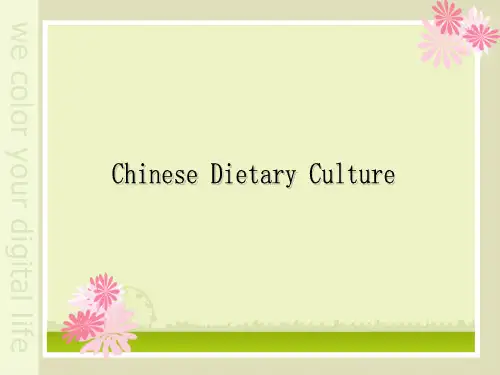
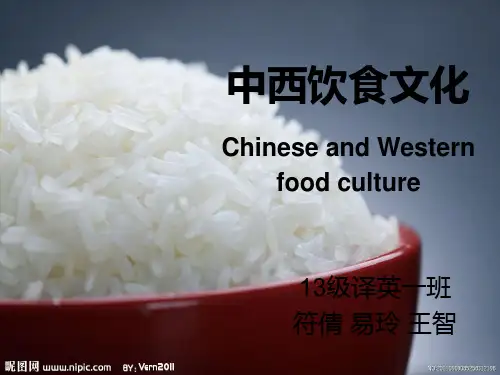
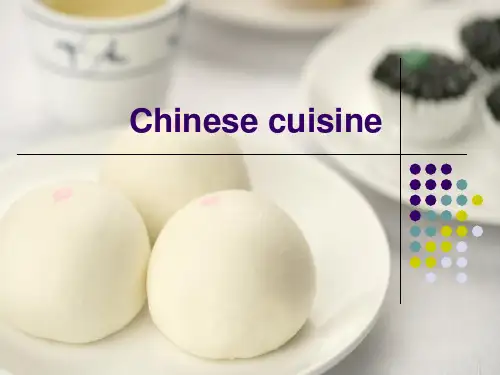

中国美食是中国各地独特的风味菜肴,涵盖了丰富多彩的烹饪文化和饮食习惯。
中国菜系有川、鲁、粤、苏、浙、闽、湘、徽八大菜系,以及少数民族菜肴等。
其中,川菜以麻辣、香辣、酸辣著名,口味醇厚,回味无穷;鲁菜讲究刀工和火候,味道鲜美、油腻适口;粤菜取材广泛,烹调方法多样,讲究鲜、嫩、滑、爽、香;苏菜口味清淡,入口醇香;浙菜鲜美可口,营养丰富;闽菜善于烹制海鲜,味道醇厚;湘菜味道香辣,口味深重;徽菜注重火功,讲究炖烧,回味无穷。
此外,中国还有许多特色小吃,如包子、饺子、煎饼、粽子、年糕等。
这些小吃历史悠久,品种丰富,口味独特,深受人们喜爱。
中国美食文化源远流长,博大精深。
它不仅是一
种饮食文化,更是一种融合了历史、地理、社会、心理等多种元素的综合性文化。
在中国,美食不仅是味觉的享受,更是一种文化传承和情感纽带。
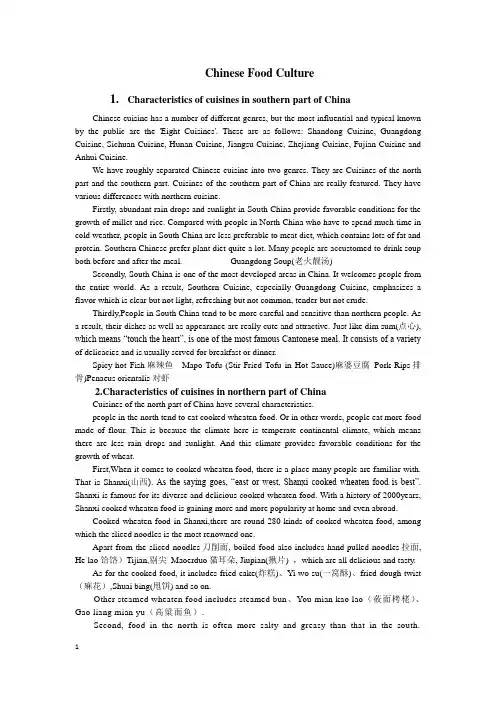
Chinese Food Culture1.Characteristics of cuisines in southern part of ChinaChinese cuisine has a number of different genres, but the most influential and typical known by the public are the 'Eight Cuisines'. These are as follows: Shandong Cuisine, Guangdong Cuisine, Sichuan Cuisine, Hunan Cuisine, Jiangsu Cuisine, Zhejiang Cuisine, Fujian Cuisine and Anhui Cuisine.We have roughly separated Chinese cuisine into two genres. They are Cuisines of the north part and the southern part. Cuisines of the southern part of China are really featured. They have various differences with northern cuisine.Firstly, abundant rain drops and sunlight in South China provide favorable conditions for the growth of millet and rice. Compared with people in North China who have to spend much time in cold weather, people in South China are less preferable to meat diet, which contains lots of fat and protein. Southern Chinese prefer plant diet quite a lot. Many people are accustomed to drink soup both before and after the meal. Guangdong Soup(老火靓汤)Secondly, South China is one of the most developed areas in China. It welcomes people from the entire world. As a result, Southern Cuisine, especially Guangdong Cuisine, emphasizes a flavor which is clear but not light, refreshing but not common, tender but not crude.Thirdly,People in South China tend to be more careful and sensitive than northern people. As a result, their dishes as well as appearance are really cute and attractive. Just like dim sum(点心), which means “touch the heart”, is one of the most famous Cantonese meal. It consists of a variety of delicacies and is usually served for breakfast or dinner.Spicy-hot Fish麻辣鱼Mapo Tofu (Stir-Fried Tofu in Hot Sauce)麻婆豆腐Pork Rips排骨)Penaeus orientalis对虾2.Characteristics of cuisines in northern part of ChinaCuisines of the north part of China have several characteristics.people in the north tend to eat cooked wheaten food. Or in other words, people eat more food made of flour. This is because the climate here is temperate continental climate, which means there are less rain drops and sunlight. And this climate provides favorable conditions for the growth of wheat.First,When it comes to cooked wheaten food, there is a place many people are familiar with. That is Shanxi(山西). As the saying goes, “east or west, Shanxi cooked wheaten food is best”. Shanxi is famous for its diverse and delicious cooked wheaten food. With a history of 2000years, Shanxi cooked wheaten food is gaining more and more popularity at home and even abroad.Cooked wheaten food in Shanxi,there are round 280 kinds of cooked wheaten food, among which the sliced noodles is the most renowned one.Apart from the sliced noodles刀削面, boiled food also includes hand-pulled noodles拉面, He lao饸饹)Tijian,剔尖Maoerduo猫耳朵, Jiupian(揪片) ,which are all delicious and tasty.As for the cooked food, it includes fried cake(炸糕)、Yi wo su(一窝酥)、fried dough twist (麻花),Shuai bing(甩饼) and so on.Other steamed wheaten food includes steamed bun、You mian kao lao(莜面栲栳)、Gao liang mian yu(高粱面鱼).Second, food in the north is often more salty and greasy than that in the south.Because people like to add more ingredient to dishes even the soup.Shandong cuisine and Beijing cuisines are two famous cuisines of the eight cuisines in china. And they are also representatives of the northern cuisines. Beijing cuisine is famous for its Beijing roast duck and instant-boiled mutton. Shandong food is always pure, fresh, tender, salty and crisp.Chinese people pay much attention to eating, not just to fulfill our basic needs, but deep within, it contains the measures Chinese people take to understand things. For example, when a child was born, relatives and friends would eat eggs painted in red color to celebrate. Eggs symbolize new lives, eating red eggs embodies the high expectations of the Chinese to carry on the family line. We have feasts in the weddings; we celebrate our birthdays with gatherings and delicious food; we gather with our friends or families to eat, which is a good way to enhance our intimacy.。

中国饮食文化介绍英文版Chinese food culture has a long and rich history dating back thousands of years. It is an integral part of Chinese tradition and plays a significant role in the daily lives of the Chinese people. From the diverse range of ingredients and cooking techniques to the intricate presentation and social significance of meals, Chinese culinary traditions embody the country's vibrant cultural heritage.At the heart of Chinese food culture lies the belief in the harmony between humans and nature. This philosophy is reflected in the emphasis on using fresh, seasonal ingredients and the careful balance of flavors, colors, and textures in each dish. The Chinese culinary approach is often described as a "yin-yang" balance, where contrasting elements such as hot and cold, sweet and sour, or spicy and mild are seamlessly combined to create a dynamic and satisfying dining experience.One of the defining features of Chinese cuisine is its regional diversity. China is a vast and geographically diverse country, and each region has developed its own unique culinary traditionsinfluenced by local climate, geography, and cultural influences. For example, the Cantonese cuisine of the southern Guangdong province is known for its delicate, lightly cooked dishes that highlight the natural flavors of the ingredients. In contrast, the Sichuan cuisine of the southwestern Sichuan province is renowned for its bold, spicy flavors and the use of Sichuan peppercorns, which create a distinctive numbing sensation.Another key aspect of Chinese food culture is the social significance of meals. Sharing food is an integral part of Chinese social rituals and family gatherings. Meals are often served family-style, with multiple dishes placed on the table for everyone to share. This encourages conversation, social interaction, and the appreciation of the diverse flavors and textures of the meal. The act of sharing food is seen as a way to foster relationships, express affection, and create a sense of community.In addition to the social aspect, Chinese cuisine also places great importance on the presentation and aesthetics of the food. The careful arrangement of dishes, the use of colorful garnishes, and the incorporation of symbolic elements, such as the use of auspicious ingredients or the arrangement of dishes to resemble lucky numbers, all contribute to the overall dining experience. The Chinese believe that the appearance of the food should be as pleasing to the eye as the flavors are to the palate.One of the most iconic and well-known aspects of Chinese food culture is the use of chopsticks. Chopsticks have been used in China for thousands of years and are an integral part of the dining experience. They are not only a practical tool for eating but also a symbol of Chinese cultural identity. The art of using chopsticks is deeply ingrained in Chinese culture, and mastering the skill is seen as a sign of cultural refinement and social etiquette.The diversity of Chinese cuisine is also reflected in the wide range of cooking techniques and methods. From the delicate steaming of dim sum to the high-heat wok-frying of stir-fries, Chinese chefs have developed a vast repertoire of cooking techniques that showcase the versatility of their ingredients and the creativity of their culinary traditions. These techniques are often passed down from generation to generation, with each chef putting their own unique spin on traditional recipes.Furthermore, the role of tea in Chinese food culture cannot be overstated. Tea has been an integral part of Chinese society for centuries and is often served alongside meals as a palate cleanser and digestive aid. The ritual of preparing and serving tea is deeply rooted in Chinese cultural practices, with different types of tea being paired with specific dishes to enhance the dining experience.In recent years, Chinese cuisine has gained global recognition and popularity, with Chinese restaurants and dishes becoming increasingly prevalent around the world. However, the essence of Chinese food culture goes beyond just the food itself. It is a rich tapestry of traditions, beliefs, and social customs that are deeply ingrained in the Chinese way of life. As more people discover the wonders of Chinese cuisine, it is essential to appreciate and understand the cultural context and significance that underlie these culinary traditions.In conclusion, the Chinese food culture is a testament to the country's rich history, diverse regional influences, and profound respect for the natural world. From the intricate balance of flavors to the social significance of meals, Chinese cuisine is a celebration of the country's cultural heritage and a window into the heart and soul of the Chinese people. As the world continues to embrace the wonders of Chinese food, it is crucial to recognize and preserve the unique cultural traditions that make it such a beloved and enduring part of the global culinary landscape.。
八大菜系中英文对照版中国的八大菜系与英文翻译中国自古就是一个拥有丰富饮食文化的国家,不同地区的菜系各具特色,味道各异。
中国的八大菜系被视为中国饮食文化的代表,它们是鲁菜、川菜、粤菜、苏菜、闽菜、浙菜、湘菜和徽菜。
下面将为大家介绍这些中国的八大菜系,并附上相应的英文翻译。
一、鲁菜(Shandong Cuisine)鲁菜,又称山东菜,是中国最著名的菜系之一,以山东地区为代表。
鲁菜讲究色、香、味的协调,注重原料的新鲜和烹调技巧的精湛。
主要特点是烹调方法多样,口味咸鲜,选料注重,制作讲究,炒、爆、炸、煮等技法熟练。
在中式烹饪中占有很重要的地位。
二、川菜(Sichuan Cuisine)川菜,又称川菜,是中国四大菜系之一,以四川地区为代表。
川味重油辣麻,以辣椒、花椒为主要调味料,口感鲜香麻辣,味道浓重,善于烹饪红烧、烧烤、干锅等菜肴。
三、粤菜(Cantonese Cuisine)粤菜,又称广东菜,以广东地区为代表。
粤菜讲究选料新鲜、制作精细,烹调技巧高超,口味清淡,口感鲜嫩,清淡鲜爽,色香味俱佳,被誉为中式烹饪之魁。
四、苏菜(Jiangsu Cuisine)苏菜,又称淮扬菜,以江苏地区为代表。
苏菜品种丰富,风味独特,以刀工精细,火工灵活,原汁原味见长,擅长烹调清蒸、红烧、炒、炸等烹调方法,口感鲜嫩。
五、闽菜(Fujian Cuisine)闽菜以福建地区为代表,是中国特色的一种菜系。
闽菜注重海鲜的烹调,食材新鲜,口味清淡,烹饪方法多样,尤其擅长海鲜的烹调,口感鲜嫩,清香爽口。
六、浙菜(Zhejiang Cuisine)浙菜,又称川菜,以浙江地区为代表。
浙菜清淡鲜香,以海鲜为主,注重鲜、嫩、淡、脆之味,注重保持菜品的本色,烹调技巧精湛,被誉为“中国菜中的山珍海味”。
七、湘菜(Hunan Cuisine)湘菜,又称湖南菜,以湖南地区为代表。
湘菜以酸辣咸鲜为主要口味,以辣椒、蒜、姜等为调味料,色香味俱佳,口感鲜甜。
餐饮产品由于地域特征、气侯环境、风俗习惯等因素的影响,会出现在原料、口味、烹调方法、饮食习惯上的不同程度的差异。
正是因为这些差异,餐饮产品具有了强烈的地域性。
中西文化之间的差异造就了中西饮食文化的差异,而这种差异来自中西方不同的思维方式和处世哲学。
中国人注重“天人合一”,西方人注重“以人为本”。
这里简要从下面三个方面谈谈中西方饮食文化的差异。
The dining product as a result of factor and so on region characteristic, climatic environment, manners and customs influences, will appear in raw material, the taste, the cooking method, the food habit varying degree difference. Was precisely because of these differences, the dining product had the intense localization. Between China and the West culture's difference has accomplished China and the West diet culture difference, but this kind of difference and gets along with people the philosophy from the West different thinking mode. The Chinese pays great attention “the beauty to uni te”, the westerner pays great attention “humanist”. here chats the Western diet culture difference briefly from the following three aspects. 第二种翻译:Food products due to geographical features, climate, customs, and other factors, will appear in the raw materials, food, cooking methods, dietary habits on the varying degrees of difference. It is precisely because of these differences in food products with a strong regional. The difference between Chinese and Western cultures to create a diet of Chinese and Western cultural differences, and differences from the West in a different way of thinking and philosophy of life. Chinese people pay attention to the "Heaven and Man," in the West focus on "people-oriented."From here, a brief talk about the following three areas in the Western diet and cultural differences.一、两种不同的饮食观念对比注重“味”的中国饮食,西方是一种理性饮食观念。
中国饮食文化英语中国的饮食独具特色,下面用英语讨论一下中国饮食的特色与文化吧。
中国饮食文化英语Famous for its abundance and exquisite, Chinese food culture has occupied an important part in the nation s tradition cultures. China is of long history with a vast territory. Due to the diversity of the climate, products and customs, there are widely different food styles and taste in local regions. Through creation by past dynasties, the long standing cooking art has formed rich and colorful local dishes. Among them, the eight major dishes enjoys the upper reputation, which consists of Shangdong, Chekiang, Sichuan, Jiangshu, Guangdong, Hunan, Fujian and Anhwei.Shandong dishes are divided into two factions as Tsinan and Jiaodong dishes. They are good at clear dishes, pure but not greasy. Sichuan dishes have enjoyed the fame that every dish has its own characteristic and none two share the same taste. They are also famous for pocked, peppery and savor taste. Chengdu and Chongqing dishes are two mail branches.Jiangsu dishes lay stress on the original taste with proper sweetness and salty. They consist of Yangzhou, Suzhou and Nanking branches. Chekiang dishes are both delicious and sweet smelling, both soft and slide, clean and not greasy. They consist of Hangzhou, Ningbo and Shaoxing branches. Guangdong dishes have Guangzhou, Chaozhou and Dongjiang three styles of dishes. They are good at choice seafood and pay more attention to the cooking skills. Theyact carefully at light food with tender and slide taste, from which they earn the praise of It has a best taste in only in Guangzhou. Hunan dishes consist of Xiangjian, Dongting Lake and Xiangxi coteau three local dishes. Their tastes lay stress on thick, arid and peppery food, mostly using seasoning like hot peppery, shallot and capsicum. Minghou, Fuzhou Ximen and Quanzhou dishes are the representatives of Fujian dishes. They use choice seafood as the main material with elaborately cooks beautiful color and delicious taste of oil. They are good at frying, gliding, decocting and pay attention to the dishes sweetness, salty, and the appearance. The most distinct features are their pickled taste . Anhwui dishes pay more attention to the taste, color of dishes and the temperature to cook them. They are expert in cooking delicacies from mountains and sea. In addition to the eight major dishes, there are Beijing dishes, shanghai dishes, Hubei dishes, liangning dishes, Henan dishes which also enjoy great reputation. What s more, the steamed dishes and vegetable dishes have their own charms. Actually, Chinese dishes have earned world s fame. The Chinese eateries could be found everywhere throughout the world. Many foreigners regard having a Chinese meal as a high honor.。